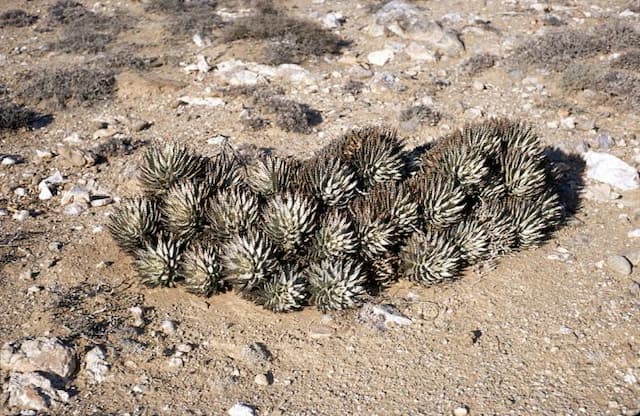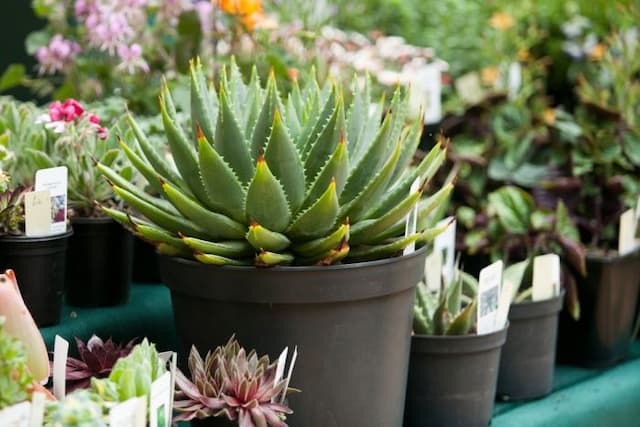Red Hot Poker Kniphofia pauciflora

ABOUT
The Red Hot Poker is a perennial plant with a bold and striking appearance. Its most distinctive feature is its flower spike, which is densely packed with tubular flowers that transition in color from a fiery red at the top to a warm yellow at the base, resembling a flaming torch or poker. The flowers are arranged on a tall, upright stem that rises above the foliage. The leaves of the Red Hot Poker are slim and arching, creating a grass-like clump at the base of the plant. The texture of the leaves is smooth, and they have a rich green color that provides a nice contrast to the vivid hues of the flowering spikes. The overall shape of the plant is vertical and somewhat spiky, making it a stand-out addition to any garden that favors bold and dramatic features. The flowers of the Red Hot Poker attract hummingbirds and other pollinators, adding an extra dimension of life to its surroundings.
About this plant
 Names
NamesFamily
Asphodelaceae.
Synonyms
Red Hot Poker, Torch Lily, Poker Plant.
Common names
Kniphofia pauciflora
 Toxicity
ToxicityTo humans
The plant commonly known as Red Hot Poker (Kniphofia pauciflora) is not widely recognized for having toxic properties to humans. There is limited information on its potential toxicity, and it is not commonly reported to cause poisoning when touched or ingested. However, like with many plants, individual sensitivities can vary, and it is possible for someone to experience adverse reactions if they have specific allergies or sensitivities. If ingested in significant quantities, it could potentially cause stomach upset or discomfort, as is common with many non-edible plant species. It is always advisable to avoid ingesting parts of ornamental plants due to the unpredictable nature of plant toxicity and potential individual reactions.
To pets
The Red Hot Poker (Kniphofia pauciflora) is also not widely known to be toxic to pets. There is limited information about its potential effects if ingested by pets such as dogs or cats. As with humans, while the plant is not typically associated with severe toxicity, individual pets may have sensitivities or allergic reactions. If a pet ingests this plant, watch for signs of gastrointestinal discomfort, which might include vomiting or diarrhea. Always keep an eye on your pets to prevent them from ingesting plants, as even non-toxic plants can cause mild stomach upset. If you suspect your pet has ingested a potentially poisonous plant or is showing symptoms of poisoning, contact your veterinarian immediately.
 Characteristics
CharacteristicsLife cycle
Perennials
Foliage type
Evergreen
Color of leaves
Green
Flower color
Yellow
Height
2 feet [60 cm]
Spread
1 feet [30 cm]
Plant type
Bulb
Hardiness zones
5
Native area
South Africa
Benefits
 General Benefits
General Benefits- Ornamental value: Kniphofia pauciflora, commonly known as Red Hot Poker, adds aesthetic appeal to gardens with its bright, showy flower spikes that attract visual interest.
- Attracts pollinators: The flowers of Red Hot Poker are known to attract bees and hummingbirds, helping to promote pollination in the garden.
- Drought tolerance: As a drought-tolerant plant, Red Hot Poker can thrive in dry conditions where other plants might struggle, making it suitable for water-wise landscapes.
- Low maintenance: Red Hot Poker typically requires minimal care once established, making it a convenient choice for gardeners of all levels.
- Versatility in landscaping: This plant can be used for various purposes in the garden, including borders, mass plantings, and as a focal point due to its striking blooms.
- Seasonal interest: Red Hot Poker has a long blooming period which can provide color and interest in the garden across multiple seasons.
- Deer resistance: The plant is generally not preferred by deer, thereby reducing the risk of damage in areas where deer browsing can be a problem for gardeners.
 Medical Properties
Medical PropertiesThis plant is not used for medical purposes.
 Air-purifying Qualities
Air-purifying QualitiesThis plant is not specifically known for air purifying qualities.
 Other Uses
Other Uses- Companion planting: Kniphofia pauciflora can be used in the garden to add diversity and attract pollinators, which in turn can benefit the growth of nearby plants.
- Soil erosion control: The fibrous root system of Red hot poker helps to stabilize soil, preventing erosion on slopes or in areas prone to heavy rain.
- Seasonal interest: Due to its unique flowering time and evergreen foliage, Red hot poker can be used to provide visual interest in gardens during seasons when other plants may not be in bloom.
- Dye production: The flowers of Red hot poker may potentially be used to create a natural dye for textiles, though this is a less common application.
- Frost protection: The evergreen leaves of Red hot poker can act as a natural frost blanket for surrounding ground, potentially protecting more sensitive plants during light frosts.
- Garden architecture: Red hot poker can be used as an architectural plant due to its upright growth habit and striking flower spikes, providing vertical interest in garden designs.
- Habitat creation: The plant can be included in garden spaces to create microhabitats that support local wildlife, such as insects and small mammals that may use the plant for cover or nesting.
- Water garden accent: Though not an aquatic plant, Red hot poker can be planted around water garden edges to add color and attract pollinators without invading the water space.
- Symbolism and education: Red hot poker can be incorporated into educational gardens or cultural landscapes where they may represent certain symbols or teach about plant ecology.
- Photography: The vibrant and unique appearance of Red hot poker makes it an excellent subject for botanical photography, drawing enthusiasts to gardens where they grow.
Interesting Facts
 Feng Shui
Feng ShuiThe Red Hot Poker is not used in Feng Shui practice.
 Zodiac Sign Compitability
Zodiac Sign CompitabilityThe Red Hot Poker is not used in astrology practice.
 Plant Symbolism
Plant Symbolism- Attention-grabbing: Kniphofia pauciflora, commonly known as Red Hot Poker, has bright and striking flowers that demand attention, symbolizing the idea of standing out or drawing focus in a situation.
- Energy and vibrancy: The intense coloration of the Red Hot Poker's blooms signifies energy, vibrance, and passion.
- Courage and boldness: With its bold appearance, the plant can represent the courage to face challenges head-on and the boldness to make daring choices.
- Transformation and change: As the Red Hot Poker goes through a significant transformation from bud to full bloom, it can symbolize change and the beauty that comes with personal growth.
 Water
WaterRed hot poker, the common name for Kniphofia pauciflora, needs to be watered regularly but with careful moderation to prevent overwatering. During its growing season in the spring and summer, it typically requires watering once a week, benefiting from about one inch of water each time. Ensure that the soil is allowed to dry out slightly between waterings to avoid root rot. Adjust the watering schedule during periods of rainfall, decreasing the amount to compensate for natural precipitation. In hotter and drier climates, more frequent watering may be necessary to keep the soil consistently moist, but not waterlogged.
 Light
LightRed hot poker thrives best in full sunlight, requiring at least six hours of direct sun per day. It should be planted in a spot where it can receive unfiltered sunlight throughout the day to support its growth and flower production. While it can tolerate some light shade, too much shade may result in weaker plants with fewer blooms. Therefore, the ideal spot for red hot poker is an open area with ample exposure to the sun, away from taller plants or structures that could cast significant shade.
 Temperature
TemperatureRed hot poker is quite adaptable to different temperature ranges but grows best in areas where the temperature is between 50°F to 85°F. It can withstand occasional dips down to 20°F but may be damaged by prolonged exposure to such cold conditions. In areas with very hot summers, red hot poker will tolerate heat well but may appreciate some protection during the hottest part of the day. Ideal growing conditions will have moderate daytime temperatures and cool nights to encourage vigorous growth and flowering.
 Pruning
PruningPruning red hot poker should be done to remove spent flower stalks and to tidy up any dead or damaged foliage. This will encourage further blooming and maintain the plant's attractive appearance. Deadheading, or cutting off the old flower spikes, should be done as soon as the blooms fade. In late fall or early spring, cut back the foliage to about 3 inches above the ground to help promote new growth. Pruning is typically done annually or as needed after blooming.
 Cleaning
CleaningAs needed
 Soil
SoilFor Red Hot Poker, a well-draining, loamy or sandy soil is best, with a preferred pH between 6.0 and 7.0. To create an ideal mix, combine two parts loam, one part peat moss, and one part sand or perlite. Ensure the soil maintains moisture without becoming waterlogged, and supplement with a balanced, slow-release fertilizer during the growing season.
 Repotting
RepottingRed Hot Pokers should be repotted every 2 to 3 years to refresh the soil and accommodate root growth. Repotting is best done in the spring or early summer when the plant is actively growing.
 Humidity & Misting
Humidity & MistingRed Hot Poker prefers moderate humidity levels, typical of outdoor conditions. Indoor growers should ensure the air isn't overly dry, but there is no need to maintain high humidity for this plant.
 Suitable locations
Suitable locationsIndoor
Place Red Hot Poker in a bright spot, avoiding intense direct sun.
Outdoor
Full sun, protect from harsh winds, and well-draining soil.
Hardiness zone
5-9 USDA
 Life cycle
Life cycleKniphofia pauciflora, commonly known as Red Hot Poker, begins its life cycle as a seed that germinates, typically in spring, under suitable temperature and moisture conditions. Seedlings emerge and establish a rosette of narrow, arching leaves, and as the plant matures, a strong root system develops. Over the years, the clump expands through vegetative growth, and once mature enough, it produces tall, robust flowering spikes in late summer or autumn. The flowers, ranging from yellow to orange and red, are tubular and arranged in dense clusters atop the spikes, attracting pollinators like birds and bees, which facilitate the cross-pollination necessary for seed production. After flowering, the plant sets seed, which can be dispersed by wind or fall close to the parent plant, ensuring the continuation of the next generation. During winter or unfavorable conditions, the plant may enter dormancy, with growth resuming as the environment becomes suitable again.
 Propogation
PropogationPropogation time
Spring to summer
The most popular method of propagating Kniphofia pauciflora, commonly known as Red Hot Poker, is by division. This is ideally done in the spring as the plant emerges from dormancy. To propagate by division, carefully dig up an established clump and gently separate it into smaller clumps, making sure each section has a portion of the root system attached. These divisions can then be immediately replanted in well-draining soil, spaced about 18 inches (approximately 45 centimeters) apart to allow for growth. Water the newly planted divisions thoroughly to help establish them. This method allows gardeners to quickly multiply their Red Hot Poker plants while maintaining the genetic consistency of the parent plant.









